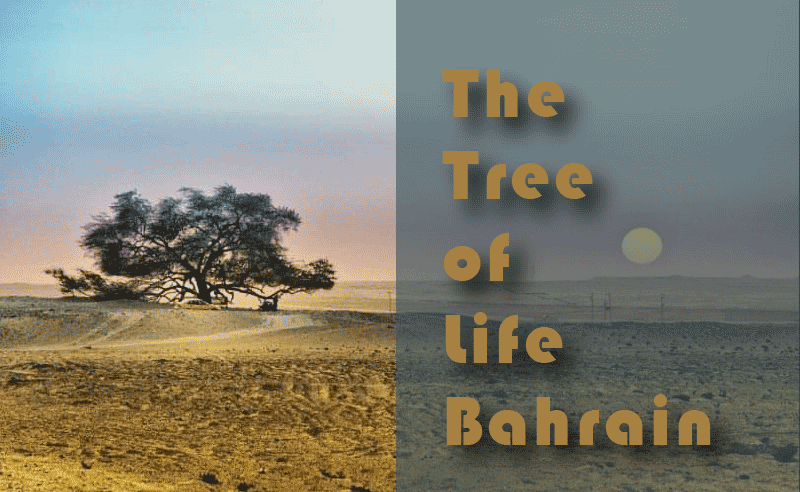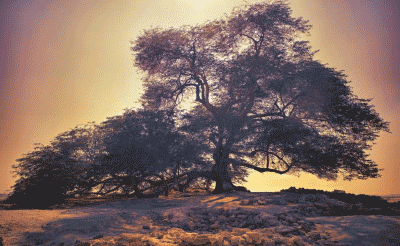Introduction to the Tree of Life Bahrain
The Tree of Life Bahrain, known locally as Shajarat-al-Hayat, stands as a monumental figure within Bahrain’s arid landscape. This prosopis cineraria tree reaches an impressive height of 9.75 meters (32 feet) and has withstood the test of time for over four centuries. Located on a hill in the desolate expanses of the Arabian Desert, it is situated approximately 6 kilometers (4 miles) from Jebel Dukhan, the highest point in Bahrain, and about 40 kilometers from the bustling capital city, Manama.
Despite the harsh climate and barren surroundings, the Tree of Life flourishes without any apparent water source. This anomaly has made it a subject of fascination and reverence, not only for locals but also for scientists and tourists from around the world. The tree’s resilience and longevity have imbued it with a sense of mystical endurance, often leading it to be regarded as a symbol of life’s perseverance against adversity.
Geographically, its isolated location in the desert amplifies its uniqueness. The tree has become an iconic landmark, drawing visitors who marvel at its solitary yet thriving existence. Culturally, the Tree of Life holds significant importance. It is often seen as a natural wonder and a testament to Bahrain’s rich heritage. Locals tell various stories and legends surrounding the tree, further embedding it in the cultural fabric of the region.
In essence, the Tree of Life is not merely a botanical marvel but a significant cultural and geographical icon. Its enduring presence continues to inspire awe and curiosity, making it an essential part of Bahrain’s natural and cultural landscape.
Historical Significance of Tree of Life Bahrain
The Tree of Life, known locally as “Shajarat-al-Hayat,” has stood resiliently in the arid Bahraini desert for over 400 years. Its endurance in such a harsh environment has made it an object of fascination and a symbol of life amidst desolation. According to historical records, the Tree of Life has been a vital landmark for generations of local communities, serving not just as a navigational point but also as a gathering place for various social and cultural activities.
Throughout the centuries, the Tree of Life has held significant importance to the people of Bahrain. Folklore and legends surrounding the tree abound, with many locals attributing its longevity to divine or mystical sources. One popular legend suggests that the tree is located at the site of the biblical Garden of Eden, further enhancing its mythical status. The tree has been the subject of numerous historical accounts, each adding layers to its rich narrative and further solidifying its place in Bahraini culture.
Over time, the Tree of Life has become more than just a natural marvel; it has evolved into a cultural and historical icon for Bahrain. It represents the strength and perseverance of the Bahraini people, mirroring their ability to thrive in challenging conditions. As such, the Tree of Life continues to be a source of inspiration and a testament to the enduring spirit of life itself.
Geographic and Environmental Setting
Situated in the heart of the Arabian Desert, the Tree of Life stands as a testament to nature’s resilience. This ancient mesquite tree, known locally as “Shajarat-al-Hayat,” is located approximately 10 kilometers from the Jebel Dukhan, Bahrain’s highest point. The Arabian Desert is characterized by its arid climate, extreme temperatures, and minimal rainfall, creating a challenging environment for any form of plant life. The region experiences scorching hot summers, with temperatures often exceeding 45 degrees Celsius, and mild winters, with temperatures averaging around 15 degrees Celsius.
One of the key factors that enable the Tree of Life to thrive in such a hostile environment is its extensive root system. The roots of the mesquite tree can extend deep into the ground, reaching depths of up to 50 meters. This remarkable adaptation allows the tree to access underground water sources that are not available to other vegetation. Additionally, the mesquite tree has a unique ability to reduce water loss through a process known as transpiration, where it regulates the opening and closing of its stomata to conserve moisture.
Another crucial aspect of the tree’s survival is its hardy nature. Mesquite trees are known for their drought resistance and ability to grow in poor soil conditions. The Tree of Life’s leaves are small and covered with a waxy coating, which further reduces water loss and protects the tree from the intense desert sun. These combined attributes allow the Tree of Life to not only survive but also flourish in an environment where few other plants can endure.
Botanical Characteristics of Prosopis Cineraria
Prosopis cineraria, commonly known as the Tree of Life in Bahrain, is a species renowned for its resilience and adaptability in arid conditions. This leguminous tree can reach heights of 10 to 15 meters, featuring a broad canopy that provides extensive shade. Its foliage is composed of bipinnate leaves, which are small, green, and finely divided, enabling the tree to reduce water loss through transpiration—a critical adaptation for survival in harsh desert climates.
The root system of Prosopis cineraria is particularly noteworthy. It possesses an extensive and deep taproot system that can penetrate up to 50 meters below the ground. This allows the tree to access deep aquifers and groundwater sources, ensuring its sustenance even during prolonged periods of drought. Additionally, a network of lateral roots spreads out horizontally, facilitating the absorption of surface water during rare rainfall events and stabilizing the soil to prevent erosion.
In terms of habitat, Prosopis cineraria thrives in arid and semi-arid regions, often found in sandy plains, gravelly soils, and rocky terrains. It is well-suited to withstand extreme temperatures and low rainfall, thanks to its drought-resistant adaptations. This species is indigenous to the deserts of the Arabian Peninsula, including Bahrain, and is also prevalent in parts of India and Pakistan.
Prosopis cineraria plays a crucial role in the ecosystem. Its presence helps in nitrogen fixation, enriching soil fertility and supporting other plant species. The tree provides habitat and food for a variety of wildlife, including birds and insects. Its pods and leaves are a significant source of nutrition for livestock, particularly during the dry season when other forage is scarce. Furthermore, the tree’s ability to stabilize the soil and prevent desertification is invaluable in maintaining the ecological balance of the arid regions where it is found.
Mysteries and Theories of Survival of Tree of Life Bahrain
The Tree of Life in Bahrain has long fascinated both scientists and locals, sparking a multitude of theories and mysteries regarding its remarkable survival. Its existence in the arid desert, devoid of visible water sources, raises compelling questions. One prevailing scientific hypothesis is that the tree taps into underground aquifers. These hidden water reserves could provide the necessary sustenance, enabling the tree to thrive in such a harsh environment. Several studies have been conducted to identify these subterranean aquifers, though concrete evidence remains elusive.
Further scientific investigations have explored the possibility of the tree’s roots extending to extraordinary depths. Deep root systems could access moisture found far below the surface, a trait that would significantly contribute to the tree’s longevity. Research into the tree’s root structure has indeed suggested that its roots are unusually deep and extensive, which could explain its ability to endure prolonged periods of drought.
In addition to scientific theories, local folklore adds a layer of mystique to the Tree of Life. One popular legend suggests that the tree stands on the site of the Garden of Eden, drawing from a blessed, eternal water source. Another tale speaks of ancient deities or spirits imbuing the tree with life-sustaining powers, protecting it from the harsh desert climate. These stories, while not scientifically verifiable, enrich the cultural and historical tapestry surrounding the tree.
Despite numerous studies and hypotheses, the true secret behind the Tree of Life’s survival remains partially shrouded in mystery. Whether it’s the reliance on hidden aquifers, an extraordinary root system, or a combination of factors, the tree continues to defy logical explanations. This blend of scientific intrigue and enchanting folklore ensures that the Tree of Life in Bahrain remains one of the world’s most captivating natural wonders.
Cultural and Spiritual Importance of Tree of Life Bahrain
The Tree of Life Bahrain, located in the heart of Bahrain, holds profound cultural and spiritual significance for the people of the region. Known locally as “Shajarat-al-Hayat,” this ancient tree has captivated the hearts and minds of Bahrainis for centuries. Its resilience in the face of arid desert conditions has earned it a revered status, symbolizing endurance and the tenacity of life. The tree’s existence is often viewed as a divine miracle, contributing to various spiritual beliefs and local folklore.
Local traditions frequently highlight the Tree of Life as a natural monument, a testament to the wonders of nature and the resilience of life. Its unique status has rendered it a source of national pride, emblematic of Bahrain’s rich cultural heritage. Schools, museums, and cultural institutions often reference the tree in educational programs, ensuring that its legacy is passed down through generations. Furthermore, the Tree of Life has inspired numerous artistic expressions, from poetry and literature to visual arts, each capturing its mystique and grandeur.
Overall, the Tree of Life stands as a powerful cultural and spiritual icon in Bahrain. Its enduring presence continues to inspire awe and reverence, making it a focal point of national identity and a symbol of the enduring spirit of the Bahraini people.
Tourism and Accessibility
The Tree of Life, or “Shajarat-al-Hayat,” is a remarkable natural wonder that draws numerous visitors each year. Located about 40 kilometers from the capital city of Manama, it stands in the southern desert of Bahrain, near Jebel Dukhan. Reaching this iconic site is feasible and straightforward, whether you are traveling from Manama or other key locations on the island. Visitors typically opt for rental cars or guided tours, both of which are readily available and provide a seamless journey to the tree.
From Manama, the drive to the Tree of Life takes approximately 45 minutes via the Shaikh Khalifa Bin Salman Highway. Signage along the route is clear, directing you towards the tree, which is well-indicated on most GPS systems. Those staying near Jebel Dukhan will find the tree even more accessible, located just a short 15-minute drive away. Public transportation options are limited, so renting a vehicle or arranging a tour is advisable for the most convenient travel experience.
Upon arrival, visitors are greeted by the sight of the lone mesquite tree towering amidst the barren desert. The site is open to the public and free of charge, allowing tourists to explore at their own pace. While the area around the Tree of Life is relatively undeveloped, certain amenities have been introduced to enhance the visitor experience. These include shaded seating areas, informational plaques, and a small parking lot. There are no on-site food or beverage vendors, so it is recommended to bring refreshments, especially during the hotter months.
As a significant tourist attraction, the Tree of Life offers a unique glimpse into Bahrain’s natural and cultural heritage. The best times to visit are during the cooler months, from November to March, when temperatures are more moderate, making the exploration enjoyable. Early mornings and late afternoons are particularly favored times, providing optimal light for photography and a more comfortable climate for visitors.
Conservation Efforts
The Tree of Life, an ancient wonder in Bahrain, stands not only as a testament to nature’s resilience but also as a symbol of the country’s rich cultural heritage. Given its significance, considerable efforts have been put into its conservation. Both governmental bodies and non-governmental organizations (NGOs) are actively involved in preserving this natural marvel.
The Bahrain Authority for Culture and Antiquities plays a pivotal role in the Tree of Life’s preservation. This governmental body collaborates closely with environmental experts and local communities to implement protective measures. Additionally, international organizations like UNESCO have also shown interest in supporting the conservation of the Tree of Life, recognizing its global cultural value.
Preserving the Tree of Life is more than just an environmental initiative; it is a commitment to safeguarding cultural and natural heritage for future generations. By maintaining this ancient wonder, Bahrain ensures that its historical and environmental narratives continue to inspire and educate both locals and visitors alike.
FAQs



Ive read several just right stuff here Certainly price bookmarking for revisiting I wonder how a lot effort you place to create this kind of great informative website
Hi i think that i saw you visited my web site thus i came to Return the favore Im attempting to find things to enhance my siteI suppose its ok to use a few of your ideas
Thank you I have just been searching for information approximately this topic for a while and yours is the best I have found out so far However what in regards to the bottom line Are you certain concerning the supply
Fantastic site A lot of helpful info here Im sending it to some buddies ans additionally sharing in delicious And naturally thanks on your sweat
Hello my loved one I want to say that this post is amazing great written and include almost all significant infos I would like to look extra posts like this
I was just as enthralled by your work as I was. Your sketch is stylish, and your written content is accurate. Although you are concerned about possibly distributing something illicit soon, I am confident that you will address this problem swiftly and return to your normal high ideals.
I was suggested this web site by my cousin Im not sure whether this post is written by him as no one else know such detailed about my trouble You are incredible Thanks.
I am truly thankful to the owner of this web site who has shared this fantastic piece of writing at at this place.
This was beautiful Admin. Thank you for your reflections.
very informative articles or reviews at this time.
This was beautiful Admin. Thank you for your reflections.
This is my first time pay a quick visit at here and i am really happy to read everthing at one place
I very delighted to find this internet site on bing, just what I was searching for as well saved to fav
I am truly thankful to the owner of this web site who has shared this fantastic piece of writing at at this place.
Wonderful beat I wish to apprentice while you amend your web site how could i subscribe for a blog web site The account aided me a acceptable deal I had been a little bit acquainted of this your broadcast provided bright clear idea
There is definately a lot to find out about this subject. I like all the points you made
Wow! This can be one particular of the most useful blogs We have ever arrive across on this subject. Actually Great. I’m also an expert in this topic therefore I can understand your effort.
Wow amazing blog layout How long have you been blogging for you made blogging look easy The overall look of your web site is magnificent as well as the content
I like the efforts you have put in this, regards for all the great content.
Wohh exactly what I was searching for, appreciate it for posting.
I was suggested this web site by my cousin Im not sure whether this post is written by him as no one else know such detailed about my trouble You are incredible Thanks
I very delighted to find this internet site on bing, just what I was searching for as well saved to fav
Fantastic beat I would like to apprentice while you amend your web site how could i subscribe for a blog site The account helped me a acceptable deal I had been a little bit acquainted of this your broadcast offered bright clear concept
I was suggested this web site by my cousin Im not sure whether this post is written by him as no one else know such detailed about my trouble You are incredible Thanks
Welcome and Thank you for your kind words
Thanks for the sensible critique. Me and my neighbor were just preparing to do a little research on this. We got a grab a book from our area library but I think I learned more clear from this post. I’m very glad to see such great info being shared freely out there.
Bundle of thanks, It means a lot